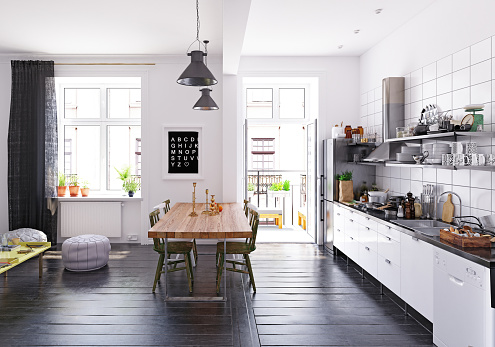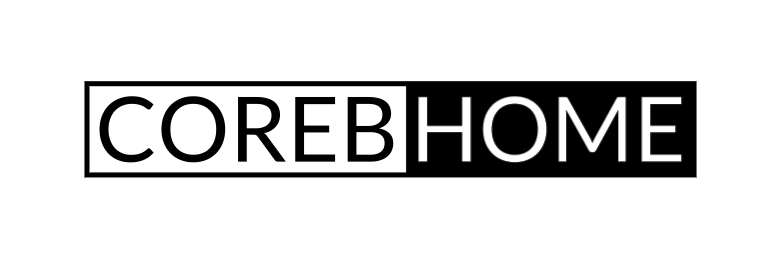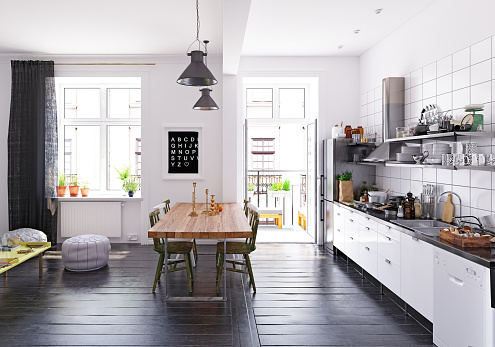In the realm of home decor, the kitchen stands as the epicenter of culinary creativity and familial warmth. The synergy between functionality and aesthetics plays a pivotal role in transforming this utilitarian space into a masterpiece. This article embarks on an exploration of the intricate world of kitchen design and decoration, delving into the professional nuances that define a culinary haven within the home.
Functional Dynamics and Spatial Efficiency
Professional kitchen design extends beyond mere visual appeal; it embodies the science of spatial efficiency. The layout is a symphony of ergonomic considerations, ensuring a seamless flow of activities. The work triangle—forging connections between the stove, refrigerator, and sink—serves as a foundational principle, promoting efficiency in culinary endeavors.
The contemporary professional kitchen embraces a holistic approach, integrating zones for preparation, cooking, and cleaning. This spatial orchestration is an essential aspect of achieving optimal functionality while accommodating the diverse demands of modern lifestyles. The interplay between form and function is heightened by the meticulous placement of cutting-edge appliances, storage solutions, and dedicated workspaces.
Materials and Finishes: A Symphony of Elegance
The choice of materials and finishes in professional kitchen design is a nuanced art. Durable and resilient, stainless steel is a hallmark material that not only exudes a sleek aesthetic but also boasts easy maintenance—a critical consideration in a culinary environment. Natural stone surfaces, such as quartz or granite, add a touch of sophistication while providing a robust foundation for culinary activities.
Cabinet finishes, often characterized by clean lines and minimalist designs, contribute to the overall aesthetic cohesion. High-quality wood veneers, laminates, or lacquered surfaces are selected not only for their visual appeal but also for their resilience against the rigors of daily kitchen use. The harmonious fusion of materials creates a symphony of elegance that defines the professional kitchen.
Precision Lighting: Illuminating Culinary Artistry
Lighting in a professional kitchen transcends its functional role, evolving into a crucial design element. Task lighting, strategically positioned to illuminate work surfaces, ensures precision in culinary endeavors. Pendant lights suspended over the kitchen island become sculptural statements, combining aesthetics with focused functionality.
Ambient lighting, often integrated into architectural elements or recessed fixtures, sets the overall mood. Dimmable options allow for a seamless transition between the bustling energy of culinary preparation and the subdued ambiance of a dining experience. The interplay of natural light, artificial lighting, and innovative fixtures transforms the kitchen into a dynamic space that adapts to the multifaceted nature of culinary activities.
Intelligent Storage Solutions
A hallmark of professional kitchen design is the integration of intelligent storage solutions. Beyond mere cabinetry, designers leverage every inch of available space to create a clutter-free and organized environment. Pull-out shelves, deep drawers, and custom-designed cabinets maximize storage capacity while ensuring accessibility.
Innovative storage solutions extend beyond conventional boundaries. Appliance garages, hidden spice racks, and specialized storage for utensils and cookware exemplify the meticulous consideration given to enhancing functionality without compromising on aesthetics. The result is a kitchen that not only looks immaculate but also operates with seamless efficiency.
Technological Integration: The Future of Culinary Innovation
The marriage of technology and culinary artistry is a defining characteristic of contemporary professional kitchens. Smart appliances, integrated digital interfaces, and state-of-the-art ventilation systems are seamlessly woven into the design fabric, enhancing both efficiency and sustainability.
Smart refrigerators with built-in cameras, touch-activated faucets, and induction cooktops with precision control are just a glimpse into the technological revolution shaping the culinary landscape. The integration of smart home systems allows for remote monitoring and control, transforming the kitchen into a space where technological innovation converges with culinary mastery.
Sustainability and Green Design
In the realm of professional kitchen design, sustainability is not merely a trend but a guiding principle. Designers are increasingly incorporating eco-friendly materials, energy-efficient appliances, and waste-reducing innovations into their creations. Recycled and locally sourced materials, water-saving fixtures, and energy-efficient lighting contribute to a kitchen that not only serves its functional purpose but also minimizes its ecological footprint.
Conclusion
The world of professional kitchen design and decoration is a captivating journey where functionality dances with elegance. Beyond the aesthetic allure, each element is meticulously curated to elevate the culinary experience to new heights. From the precision of lighting to the intelligent integration of technology and the embrace of sustainable practices, the professional kitchen stands as a testament to the harmonious blend of art and functionality. As we navigate the ever-evolving landscape of design, the professional kitchen remains a canvas where culinary aspirations and design excellence converge, creating a space that transcends the ordinary and defines the extraordinary.










No Comment